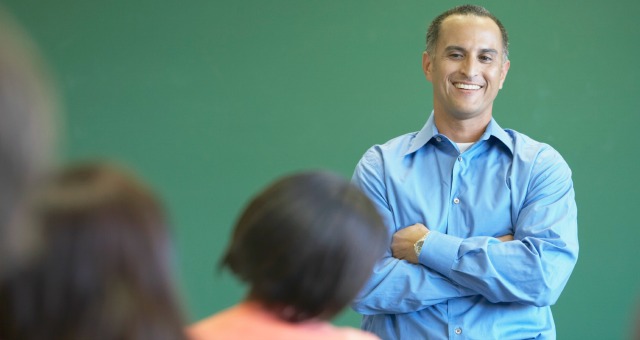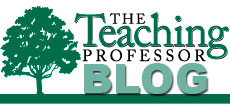 Editor’s note: The following is an excerpt from the article An examination of factors and attitudes that influence reporting fraudulent claims in an academic environment, Active Learning in Higher Education, 15 (2), 173-185. The Teaching Professor Blog named it to its list of top pedagogical articles late last year.
Editor’s note: The following is an excerpt from the article An examination of factors and attitudes that influence reporting fraudulent claims in an academic environment, Active Learning in Higher Education, 15 (2), 173-185. The Teaching Professor Blog named it to its list of top pedagogical articles late last year.
CURRENT ARTICLE • July 08
OTHER RECENT ARTICLES
For both new and veteran faculty, inheriting a syllabus to teach from is like being blindfolded on a long journey and being told, “Don’t worry, you’ll know it when we get there.” There’s a lot of trust required in order to follow someone else’s map. There are road hazards the mapmaker may not be aware of; there may be alternate routes that might get you there more directly; and it may even be prudent to choose another mode of transportation to get there.
Read More › The influx of nontraditional adult students in higher education has resulted in unprecedented institutional competition. Colleges and universities, vying for attention and increased enrollments, seek creative solutions to attract and retain students. Many degrees have been designed or modified to follow the cohort model, creating temporary cultures of students who participate in programs following an accelerated lockstep sequence. Cohorts start and finish programs as collective groups and share instructors and experiences along the way. Productive learning environments and the temporary culture of a group encourage student productivity and enhance the overall academic experience.
The influx of nontraditional adult students in higher education has resulted in unprecedented institutional competition. Colleges and universities, vying for attention and increased enrollments, seek creative solutions to attract and retain students. Many degrees have been designed or modified to follow the cohort model, creating temporary cultures of students who participate in programs following an accelerated lockstep sequence. Cohorts start and finish programs as collective groups and share instructors and experiences along the way. Productive learning environments and the temporary culture of a group encourage student productivity and enhance the overall academic experience.
 In general education humanities courses, at least two problems seem universal:
In general education humanities courses, at least two problems seem universal:
 Getting students to do their assigned reading is a struggle. Most teachers don’t need anyone to tell them what the research pretty consistently reports. On any given day, only 20 to 30 percent of the students arrive at class having done the reading. Faculty are using a variety of approaches to up that percentage: quizzes (announced, unannounced, online), assignments that require some sort of written response to the reading, reading journals, a variety of optional reading support materials, and calling on students to answer questions about the reading. Which of these approaches work best?
Getting students to do their assigned reading is a struggle. Most teachers don’t need anyone to tell them what the research pretty consistently reports. On any given day, only 20 to 30 percent of the students arrive at class having done the reading. Faculty are using a variety of approaches to up that percentage: quizzes (announced, unannounced, online), assignments that require some sort of written response to the reading, reading journals, a variety of optional reading support materials, and calling on students to answer questions about the reading. Which of these approaches work best?
Language influences thought and action. The words we use to describe things—to ourselves and others—affects how we and they think and act. It’s good to remind ourselves that this powerful influence happens in all kinds of situations and most certainly with language related to teaching and learning.
Read More › Let’s face it: some courses are simply more applicable to the job market than others. For some, it’s easy to make the connection between what is taught in the classroom and the skills needed for landing that perfect job. But, what about those courses that are not geared toward generating employment?
Let’s face it: some courses are simply more applicable to the job market than others. For some, it’s easy to make the connection between what is taught in the classroom and the skills needed for landing that perfect job. But, what about those courses that are not geared toward generating employment?
 It had happened before, sitting at the computer, working on a syllabus, again, fluctuating between excitement about a new course and a vague sense that life itself was being sucked out of me one sterile byte at a time. I was fighting boredom. And this was supposed to interest students? I tried to imagine it igniting their curiosity, but instead I saw them staring at it with the enthusiasm saved for the fine print on a life insurance policy. But they must read it. It is their life insurance policy for a future full of knowledge and wisdom! It defines how we’re going to relate! As I sat there writing my syllabus I had a vision of the Ferris Bueller video of the professor droning on and on while asking for input: “Anyone? Anyone?” That was not where I wanted to go. I had to stop and rethink what I was doing.
It had happened before, sitting at the computer, working on a syllabus, again, fluctuating between excitement about a new course and a vague sense that life itself was being sucked out of me one sterile byte at a time. I was fighting boredom. And this was supposed to interest students? I tried to imagine it igniting their curiosity, but instead I saw them staring at it with the enthusiasm saved for the fine print on a life insurance policy. But they must read it. It is their life insurance policy for a future full of knowledge and wisdom! It defines how we’re going to relate! As I sat there writing my syllabus I had a vision of the Ferris Bueller video of the professor droning on and on while asking for input: “Anyone? Anyone?” That was not where I wanted to go. I had to stop and rethink what I was doing.
W hen you take ideas to places of extremity, they become distorted. “It is not part of my job to make you learn,” Philosophy Professor Keith M. Parsons writes in his syllabus to first-year students. “At university, learning is your job—and yours alone. My job is to lead you to the fountain of knowledge. Whether you drink deeply or only gargle is entirely up to you.”
Read More ›If you’re a regular reader of this blog, you’re already aware that flipped instruction has become the latest trend in higher education classrooms. And for good reason. As it was first articulated by Bergmann and Sams, flipped instruction personalizes education by “redirecting attention away from the teacher and putting attention on the learner and learning.” As it has evolved, the idea of flipped instruction has moved beyond alternative information delivery to strategies for engaging students in higher-level learning outcomes. Instead of one-way communication, instructors use collaborative learning strategies and push passive students to become problem solvers by synthesizing information instead of merely receiving it. More recently on this blog, Honeycutt and Garrett referred to the FLIP as “Focusing on your Learners by Involving them in the Process” of learning during class, and Honeycutt has even developed assessments appropriate for flipped instruction. What's been left out of the conversation about flipped classrooms, however, is why and how we might also need to flip assessment practices themselves.








